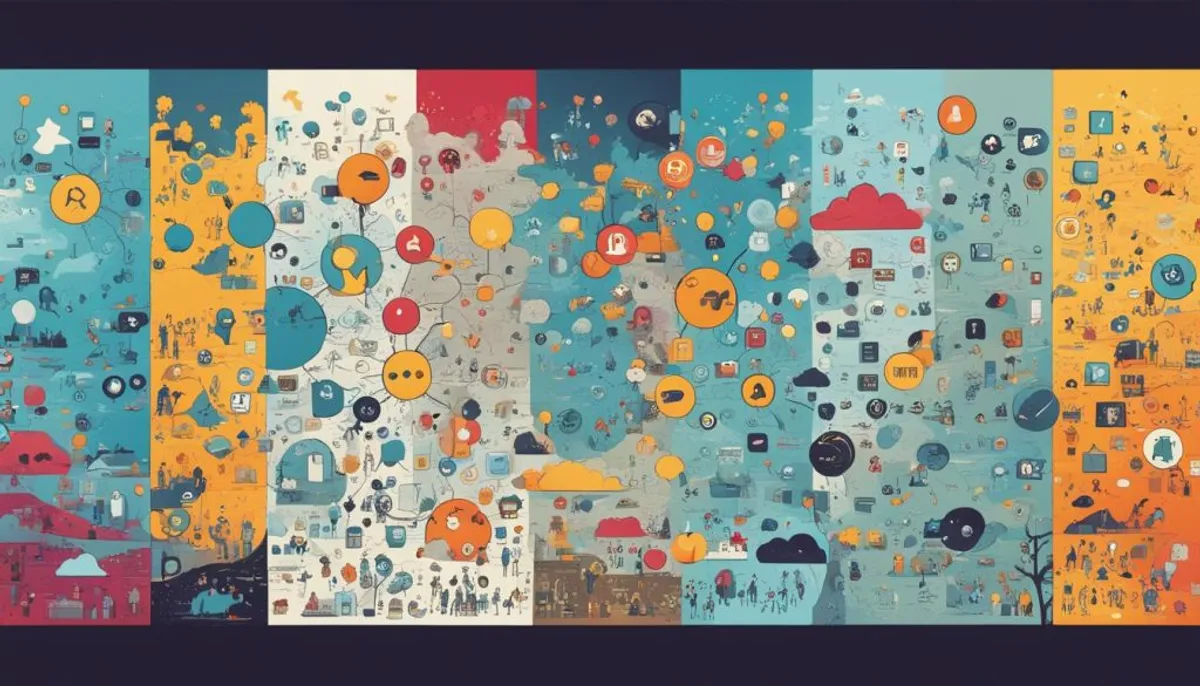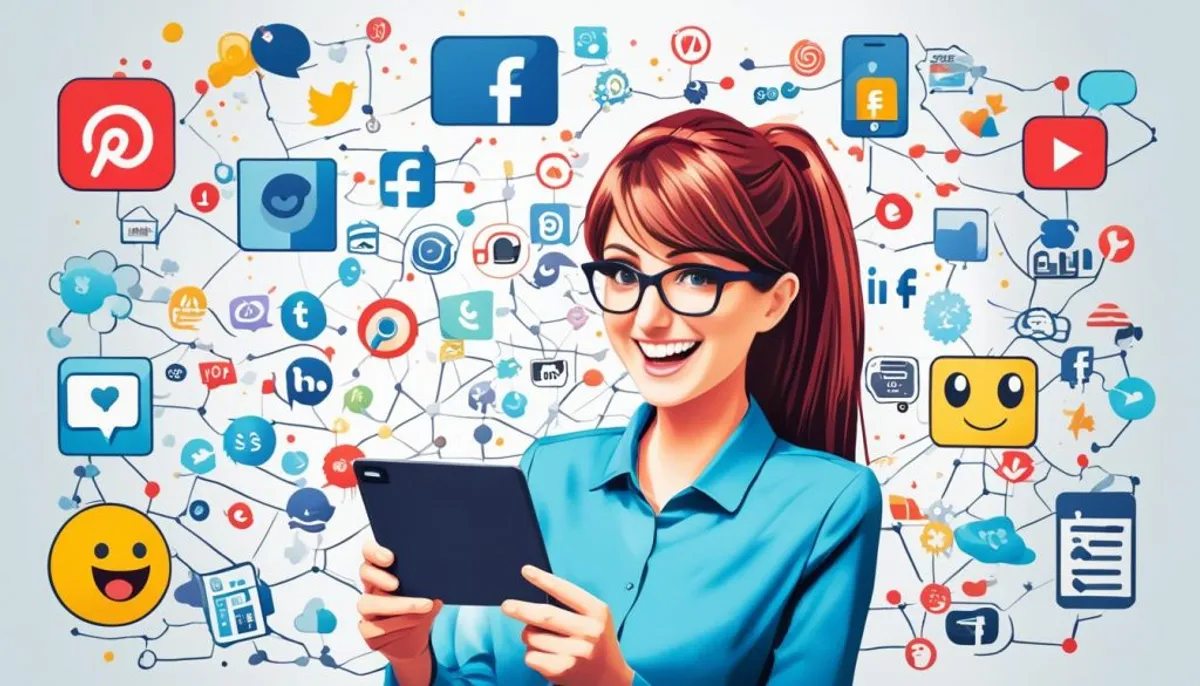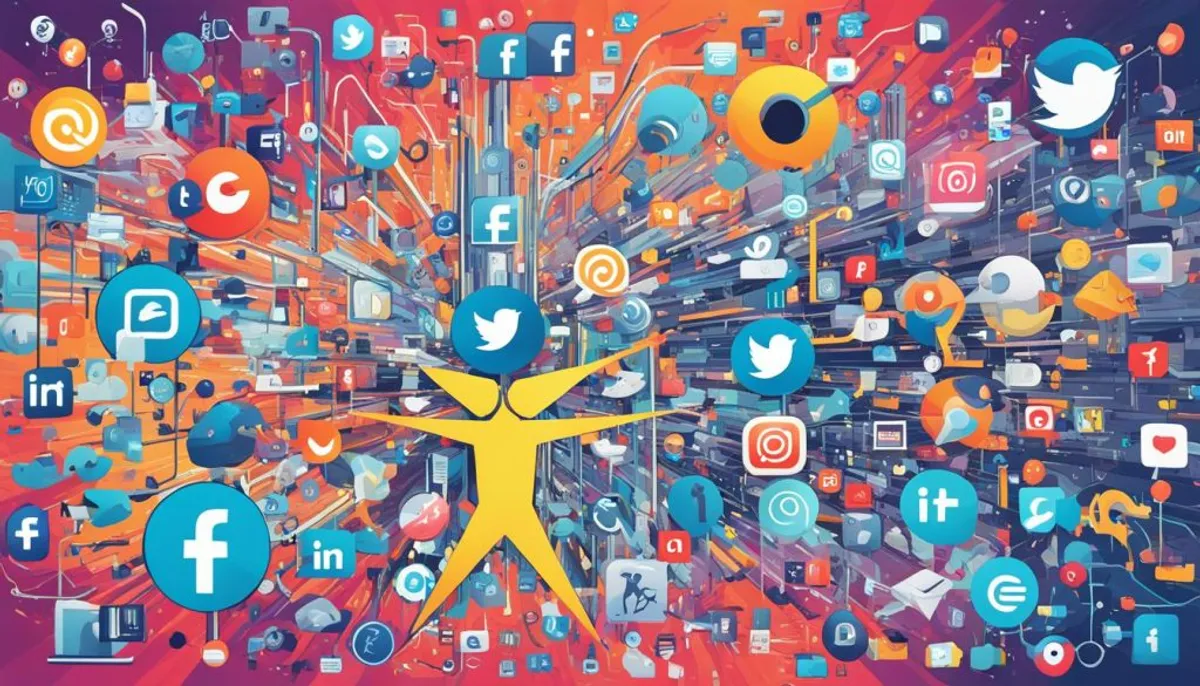Have you ever wondered how social media started? The story of social networking is quite interesting. It goes all the way back to the early days of communication technology. Let’s dive into how social platforms began and the rise of social networking sites.

Social networking didn’t start with the internet as we know it. It began with the telegraph in 1792, enabling messages over long distances. Then, in 1890, the telephone changed things by letting people talk directly.
In 1997, the world saw the first social networking site, “Six Degrees.” This site laid the foundation for future social media, connecting users. Here, people could create profiles, make friends, and message each other.
After “Six Degrees,” social media kept growing. LinkedIn launched in 2002, focusing on work connections. Then Myspace became huge in 2003. But, in 2004, Facebook changed everything, making online connections easier than ever.
The story of social networking is marked by many platforms. YouTube, Twitter, Instagram, Snapchat, and TikTok have all been huge. Each has changed how we share things, meet people, and present ourselves online.
Key Takeaways:
- Social networking began with the telegraph and telephone in the late 18th and 19th centuries.
- The first social networking site, “Six Degrees,” was launched in 1997.
- LinkedIn, Myspace, and Facebook played significant roles in the development of social media.
- Platforms like YouTube, Twitter, Instagram, Snapchat, and TikTok have shaped how we connect and communicate online.
- The history of social networking showcases the quick growth of online networks and the birth of various social media platforms.
The Pre-Internet Roots
Social media started way before the internet, with the telegraph in 1792 and the telephone in 1890. These inventions changed how we communicate, allowing messages to be sent over long distances.
The telegraph sent messages through electrical signals. It was the first step towards instant communication. The telephone then introduced real-time voice chats, connecting people far apart.
Even though these early forms of social networking were basic, they were crucial. They introduced the idea of staying connected without being close. The telegraph invention and telephone began the era of long-distance communication.
The creation of ARPANET in 1969 marked the start of digital networking. It was a special data network for scientists. This network shared information across different places. It was the beginning of the internet as we know it.
In 1987, the National Science Foundation Network (NSFNET) came to be. It linked educational and research bodies. This network was a big improvement and helped shape social media platforms.
These steps in digital communication and network development were key. They prepared for the rise of social media in later years.
The Evolution of Digital Communication
It’s vital to see how digital communication evolved before social media. The telegraph and phone were big milestones. But ARPANET and NSFNET truly laid the internet’s foundation. They helped social networking grow.
“The telegraph and telephone revolutionized communication by enabling instant messaging and real-time voice conversations.”
These inventions led directly to our interconnected world today, connecting people. Without the telegraph, telephone, ARPANET, and NSFNET, there would be no social media.
| Key Milestones | Year |
|---|---|
| Telegraph Invention | 1792 |
| Telephone Invention | 1890 |
| ARPANET Creation | 1969 |
| NSFNET Launch | 1987 |
The Launch of Social Sites
The story of social media starts back in the 1980s and 1990s. This was when CompuServe, America Online, and Prodigy first showed up. They introduced us to the world of online chats and communities.
CompuServe kicked things off in 1969 with their email services and chat options. In the 1990s, America Online, or AOL, became a big deal. They offered email, chats, and online community access. Prodigy started in 1988, giving users news, email, and bulletin boards to explore.
These platforms were just the beginning. They set the stage for true social networks. Six Degrees came out in 1997. It let people create profiles and make connections. Even though it closed in 2001, it started something big.
Six Degrees was the first to let people make profiles and connect online. It led to the social media boom that came after.
In 2001, Friendster appeared and became a hit. It was a place to share photos, post comments, and make new friends. It was the first big social network.
Then came Myspace in 2003. It quickly became super popular. Users could add music, videos, and cool layouts to their profiles. It was a big part of the social media world.
Around that time, LinkedIn started too. It was 2002, and LinkedIn focused on professionals. This platform let people grow their careers and show off their skills.
Thanks to these pioneers, social networking exploded. They changed how we meet, talk, and share online, playing a crucial role in staying connected across the globe.
| Early Social Media Platforms | Launch Year |
|---|---|
| CompuServe | 1969 |
| America Online (AOL) | 1985 |
| Prodigy | 1988 |
| Six Degrees | 1997 |
| Friendster | 2001 |
| Myspace | 2003 |
| 2002 |
Modern Social Media Outlets
Today, platforms like Facebook, Reddit, Twitter, Instagram, Pinterest, Snapchat, and TikTok rule social media. They have changed how we connect, talk, and share online, much like the early social media platforms that paved the way for these modern networks.
Facebook, started in 2004, is still very popular with almost 1.7 billion users globally. You can make profiles, connect with friends, share photos and videos, and join groups. The rise of early social media platforms has paved the way for such connectivity.
Reddit, created in 2005, blends news with social comments. It has “subreddits” for different topics. Users can discuss and vote to change what’s seen.
Twitter, born in 2006, is great for short posts. These “tweets” can be up to 280 characters. It’s used for instant news, opinions, and following famous people.
Instagram, launched in 2010 and bought by Facebook, is all about photos. Users post and edit photos and videos for their followers. The impact of technology on media is evident as Instagram now has Stories, Reels, and IGTV too.
Pinterest is perfect for finding new ideas. It lets you save and organize images and links. It’s great for DIY, recipes, fashion, and home decor.
Snapchat and TikTok are hits with the young for videos. Snapchat has fleeting photos and videos. TikTok lets you make fun, short videos with cool effects.
Social Media Platform Overview
| Social Media Platform | Year Launched | Main Features |
|---|---|---|
| 2004 | Profile creation, friend connections, photo and video sharing, groups | |
| 2005 | News-sharing, social commentary, voting system | |
| 2006 | Microblogging, real-time conversations, trending topics | |
| 2010 | Photo and video sharing, Stories, Reels, IGTV | |
| 2010 | Visual pinboards, content discovery, following accounts | |
| Snapchat | 2011 | Photo and video sharing, disappearing content |
| TikTok | 2016 | Short video creation, effects, filters, soundtracks |
These platforms have changed our daily communication and sharing habits, including the rise of instant messaging. Each offers something special for different tastes, ages, and content preferences. From getting news on Twitter, sharing with friends on Snapchat, to finding ideas on Pinterest, these platforms are part of our life.
Social Media: End Users and Businesses
Social media has changed how we connect and talk to each other. This change affects society and how we buy things. Now, 72% of American adults use some kind of social media.
People use social media to keep in touch with loved ones and meet others with the same interests. It’s a space for sharing stories, ideas, and content. This builds a feeling of community.
Social media lets people shape how they are seen online. They can show off what they like, their achievements, and be creative. It’s a place to share thoughts and talk about important topics.
Businesses see social media’s big potential and how it helps their marketing. Networks like Facebook, Twitter, and Instagram offer ways to reach people and promote what they offer.
Marketing on social media is key for companies today. They can target ads and reach lots of people. This helps them become more known, get more website visitors, and find leads.
It’s also important for companies to make interesting content and have a strong social media profile. This helps them lead in their industry and keep customers loyal.
Companies can talk to their customers directly through social media and instant messaging. They can answer questions, solve problems, and learn what people like. This helps them better serve their customers.
The Power of Social Media Marketing
Table: Comparative Analysis of Social Media Platforms for Business Applications
| Platform | Key Features | Target Audience |
|---|---|---|
| Extensive advertising options, detailed audience targeting, robust analytics | Wide range, general audience | |
| Real-time updates, trending hashtags, direct customer engagement | News enthusiasts, influencers, businesses | |
| Visual storytelling, influencer marketing, user-generated content | Youthful demographic, lifestyle brands, visual content |
Social media marketing gives companies great chances for growth. Using social media wisely, businesses can meet their goals. The changing social media world offers many new ways to reach people.

The number of social media sites and tech advances keep growing, including early social media platforms. Businesses need to keep up with new trends like virtual reality and AI. Staying updated helps them connect with people in meaningful ways.
How Marketing Pros Utilize Social Media
Social media has changed the way marketing is done. Marketing pros use user data to target specific groups effectively. Through social media advertising, companies can efficiently reach their audience.
On platforms like Facebook and Twitter, you can choose who sees your ads. You can select based on demographics, interests, and behavior. This kind of data-driven marketing makes sure ads reach the right people, increasing conversion chances.
Having a strong social media presence is essential for companies. They can connect with their audience by creating interesting content. Facebook, Instagram, and Twitter are key for businesses to interact and showcase their products or services.
“Social media advertising has transformed the way businesses reach and engage with consumers. By utilizing data-driven targeting and maintaining an active social media presence, marketers can effectively drive results and build brand awareness. The telegraph invention marked a significant turning point in communication, paving the way for modern marketing strategies. Additionally, early social media platforms and instant messaging have become essential tools for real-time communication, allowing businesses to connect with their audience more directly. Furthermore, advancements in communication technology have played a crucial role in enhancing these interactions.”
The Power of Content Creation
Making engaging content is crucial for keeping social media users interested. Companies should create content that is valuable, fun, or educational. This might include great visuals, strong writing, and interactive elements like videos or quizzes.
Understanding what your audience likes is important for content creation. Marketers use analytics from social media and social media monitoring tools to learn about audience behaviors and interests. With this info, they make content that the audience loves, boosting engagement and brand strength.
But it’s not just about single posts. Marketers need a full strategy that fits the brand’s identity and goals. Being consistent, genuine, and relevant helps keep a strong social media presence and connect with the audience.
Benefits for Businesses
Social media marketing offers many advantages to businesses:
- Enhanced targeting: Social media ads help businesses precisely find and reach potential customers, leading to more conversions and better returns.
- Increased brand visibility: Being active on social media helps businesses get more exposure, connect with their audience, and boost brand awareness.
- Greater customer engagement: Businesses can grow meaningful relationships with their customers by sharing compelling content and interacting regularly.
- Access to real-time feedback: Companies can quickly get customer feedback on social media, allowing them to address issues, make changes, and improve customer service.
Social media is a key tool for marketing experts today. By using social media advertising, following a data-driven strategy, making appealing content, and keeping up a dynamic social media presence, companies can tap into social media’s full potential to reach their marketing goals. Additionally, understanding the concept of social catfish can help marketers navigate the complexities of online interactions.
| Benefits of Utilizing Social Media for Marketing | |
|---|---|
| Enhanced targeting | Increased brand visibility |
| Greater customer engagement | Access to real-time feedback |
What’s Next For Social Media
The future of social media looks thrilling. With new tech, including advancements in communication technology, we will see big changes in how we connect and share. Here are some major trends to watch:
Virtual Reality and Augmented Reality
VR and AR will change social media. They offer ways to dive deep into content, mixing the virtual and real. This means sharing and enjoying posts in exciting, new ways.
Live Streaming
Live streaming is getting bigger. On platforms like Facebook Live and Instagram Live, people can share moments instantly. This lets users touch base with others in a real and personal manner.
AI-Powered Content
AI is reshaping how we make and see content. Tools like Phrasee use AI to make content better, getting more people involved. AI will soon let us make content that really speaks to viewers, tailored just for them.
“The future of #socialmedia is filled with exciting possibilities.”
Social media is heading in new directions. It’s becoming more than just platforms; it’s about immersive, interactive experiences. As new tech comes into play, social media grows, offering new ways for us to connect and share stories.

| Trend | Key Features |
|---|---|
| Virtual Reality and Augmented Reality | Immersive experiences, blending virtual and physical worlds |
| Live Streaming | Real-time engagement and interaction |
| AI-Powered Content | Optimized and personalized content generation |
Conclusion
Online communication has grown fast because of social networking sites. We’ve moved from the telegraph to giants like Facebook and TikTok. This shows how big an effect these platforms have had on our world.
Social media changed how we stay in touch. It lets us keep up with friends and family no matter where they are. It has also given businesses new ways to reach out to customers. The impact on people and companies is huge.
The future of social media looks bright. With new tech like virtual reality and AI, the way we use social media will keep changing. Live streaming is already popular, and more changes are coming. Social media will become even more important in our lives.
We’ve seen a lot of change in how we talk to each other online. Social media has made a big mark on our society. Looking ahead, there are many exciting changes to come in the world of social media.
FAQ
When did social networking begin?
Social networking started with the telegraph in 1792 and the telephone in 1890.
What is the history of social networking?
It began before the internet and grew with early social media platforms in the 1990s and 2000s.
What are the origins of social media?
It began with the telegraph and telephone, before the internet era.
When were the first social networking sites launched?
“Six Degrees,” the first site, started in 1997. Soon, LinkedIn, Myspace, and Facebook followed.
Which social media platforms are the most popular today?
The big names now are Facebook, Reddit, Twitter, Instagram, Pinterest, Snapchat, and TikTok.
How has social media impacted society?
It has changed how we connect and talk, affecting our personal and professional lives.
How do businesses utilize social media?
Companies use Facebook, Twitter, and Instagram for marketing.
What is the future of social media?
Social media’s future looks bright, with tech like virtual and augmented reality coming into play.
RelatedRelated articles



